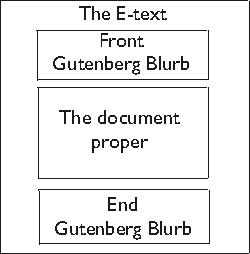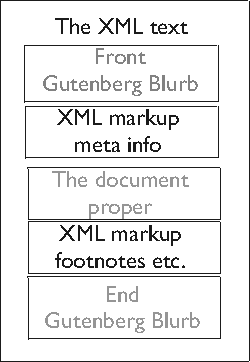![[The HTML Writers Guild Logo]](../../images/lo-025.gif)
Welcome to the
HTML Writers Guild

Marking up an e-text I.
This section tells you about the content of an e-text and also gives a brief description of how a book is organized. The next sections will go into the actual detail of how to mark up a book. You may want to print out these sections for easy reference.
The parts of an e-text
When you down load an e-text you will see that it consists of the following parts.
- A blurb at the beginning that has been added by the Gutenberg project. This contains meta details concerning the original transcription to electronic form. This should be preserved in its entirety.
- The document proper. It goes without saying that we should not alter this. If you do encounter what you perceive to be an error, you may record your thought with a foot note, but DON'T alter the text!
- There is usually some additional material at the end that has been added by the Gutenberg people. This too should be preserved.
Our task will be to preserve all the original structure while adding meaning to it using mark up. The following figure illustrates the parts of an e-text graphically.

We will also add two additional parts.
- We will add 'meta' information about the document, including markup history, revision history etc. The content of this will be discussed under the individual mark up criteria.
- After the document there will be a place for foot notes. This area will contain explanations for why we may have marked up certain text the way we have.
This is illustrated in the following figure

Let's now look at the parts of a book
The parts of a book
Almost any book or document can be divided up into three parts
- Front matter
- The body of the book or document
- Back matter
The following paragraphs are a brief account of these divisions, as they most commonly are seen in a modern publication. It should be remembered that not all books will include all these divisions, and many will have extra divisions that are not easily described. When you encounter these you must use your native wits to decide how to mark up the document!
These descriptions are adapted for the most part from "The Chicago Manual of Style" ( The University of Chicago Press ), a book well worth investing in if you have an interest in authoring or typography in general.
Book frontmatter
The Half-Title page
The half title page usually only carries the title of the book
Title page
The title page contains the title, any sub tile and information about the Author, also other information such as the edition number , the publisher etc.
Copyright page
This contains a whole lot of information in a modern text. In historic texts much of the usual information is missing, and indeed a copyright page may not even be present.
Dedication
If present, this will usually be on its own page.
Epigraph
This may be a pertinent quotation or statement.
Table of contents
These are usually kept separate from the other tables. The actual page numbers are of no meaning in e-texts and are often omitted.
List of Illustrations
In more modern books these may be subdivided into various types such as plates, illustrations, figures, and maps.
List of Tables
See above ToC
List of Maps
In older books these were often kept separate from the illustrations.
Foreword
A foreword is an introduction by someone other than the author, and is often some famous person.
Preface and Acknowledgments
This may include the motivation for writing the book, and the help received from various sources
Introduction
This includes material that is related to the main text of the book and which should be read before the rest of the book
Other Front matter
- List of abbreviations
- Editorial method
- List of contributors
- Chronology
The book body
The body of the book itself consists of the text, maps and illustrations of the book. The simplest division is in to a chapter, with each chapter containing a chapter title, or possibly a chapter number, and a number paragraphs. The paragraphs may be divided into subsections.
Most of the e-texts will not have illustrations. If you wish to
add an illustration from the original text then you can, but great
care must be taken that it is from the original text, and not added
in some recent addition. We would suggest the use of the
'.png' format for illustrations.
Chapters
A chapter may have a title or a number. Often a chapter will be preceded by a quotation or a summary. Subsections and subheads should be preserved.
Subheads
Some chapters may have several levels of subsections. If this is the case care must be taken to preserve the hierarchy in the markup.
Footnotes
Footnotes and side notes if present need to be marked as such. With illustrations, some need to occur in the text, i.e. their position is meaningful, and they need to appear inline at the point of
Parts
A large book may be broken down into parts. when this is the case, often each part is given it's own title page. Sometimes the chapter numbering starts gain from 1.
other divisions
Poetry
Poems usually have titles. The preservation of white space is important, and markup should clearly indicate the divisions in the poetry.
Letters and Diaries
Letters are usually listed in chronological order rather than in chapters.
Plays
Plays have their own special markup's and division, and in many cases (e.g. Shakespeare) the markup will have much in common with poetry.
Epilogues, Afterwords and Conclusions
These are unnumbered. Sometimes however they can be almost as long as the chapters themselves. Keep the same formatting for these as you do for the chapters.
Book backmatter
Appendices
Like Chapters these can have titles, numbers and subsections.
Glossary
A list of terms with their definitions
Bibliography or Reference list
A list of suitable reading matter
Index
An index is a list of items with page references. In an e-text of course the page references, if present will bear no relationship to the text. This is usually omitted in e-texts.
Colophon
A colophon may be an embellishment, or it may be a brief description of the facts of production.
Revision History (Marking up an e-text I)
Original material prepared by: Author: Frank Boumphrey date: 1/13/00 email: frank@hwg.org for: HWG Project Gutenberg © The HTML Writers Guild